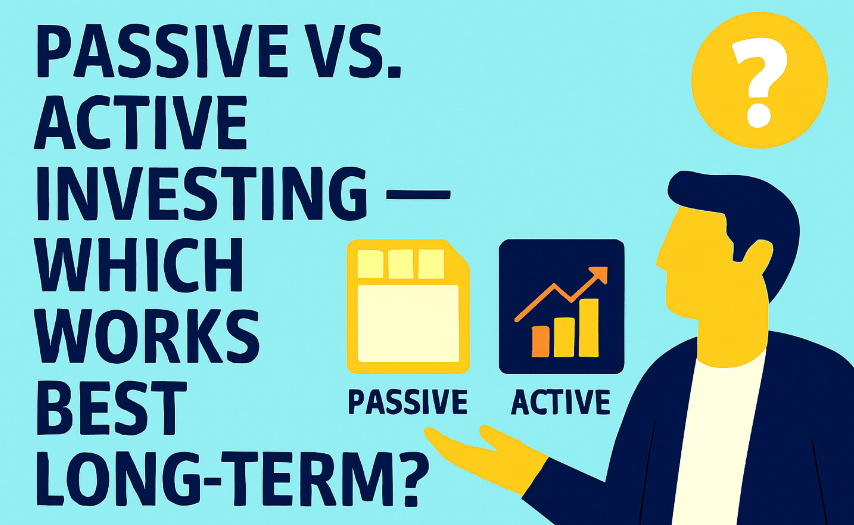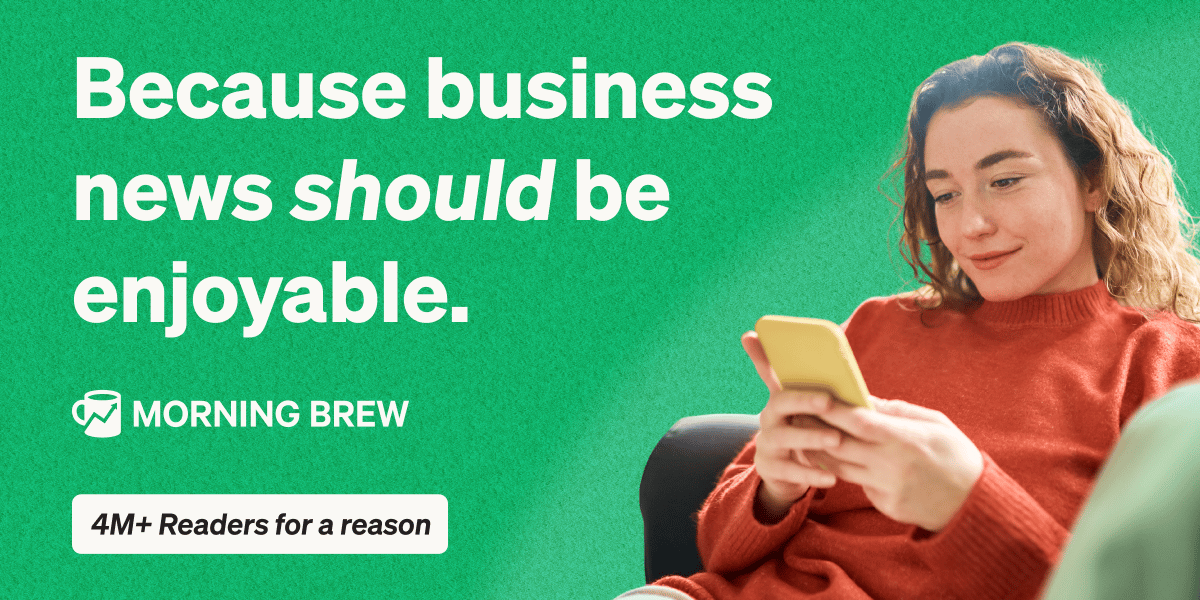- Live Life Grow Wealth
- Posts
- 🌍 Series 3 Day 6: Passive vs. Active Investing — Which Works Best Long-Term?
🌍 Series 3 Day 6: Passive vs. Active Investing — Which Works Best Long-Term?

Today’s Headline
🌍 Series 3: Building a Strong Investment Portfolio
Day 6: Passive vs. Active Investing — Which Works Best Long-Term?
When I first started investing, I thought the only way to make money was by actively buying and selling stocks — watching charts, following market news, and trying to catch “the next big thing.” But over time, I discovered that there’s another approach that doesn’t require constant monitoring, and yet often performs just as well (or even better) in the long run — passive investing.
Today, let’s talk about these two styles — active investing and passive investing — and understand which one might suit you better for building long-term wealth.
"Stay ahead in the world of business and finance with Morning Brew—your daily dose of market insights and financial trends. Click here to subscribe now!"
An espresso shot for your brain
The problem with most business news? It’s too long, too boring, and way too complicated.
Morning Brew fixes all three. In five minutes or less, you’ll catch up on the business, finance, and tech stories that actually matter—written with clarity and just enough humor to keep things interesting.
It’s quick. It’s free. And it’s how over 4 million professionals start their day. Signing up takes less than 15 seconds—and if you’d rather stick with dense, jargon-packed business news, you can always unsubscribe.
What Is Active Investing?
Active investing means you or a fund manager are trying to beat the market. You buy and sell investments regularly, hoping to profit from price changes.
It’s like being a driver on a racetrack. You’re steering every turn, adjusting speed, overtaking others, and reacting to what’s happening in real time.
In investing, that means:
Picking individual stocks or funds you think will outperform.
Timing when to enter and exit the market.
Constantly analyzing charts, company reports, and global news.
The goal? To earn more than the average market return.
For example, if the S&P 500 (which tracks 500 big U.S. companies) grows 10% in a year, an active investor tries to make more than 10% by picking better-performing stocks.
But here’s the truth — even professional fund managers who spend their entire careers doing this rarely beat the market consistently year after year.
What Is Passive Investing?
Passive investing is the opposite. Instead of trying to beat the market, you try to match it.
It’s like setting your car on cruise control. You’re still moving forward, but you’re not swerving or speeding unnecessarily.
A passive investor usually buys index funds or exchange-traded funds (ETFs) that mirror a market index such as the S&P 500, NASDAQ, or Straits Times Index.
This approach means:
You don’t have to constantly watch the market.
You don’t need to pick individual stocks.
You simply invest regularly and let time do the work.
Passive investing is based on a powerful truth — markets grow over time. While there are ups and downs, history shows that over decades, markets have generally gone up.
The Battle Between the Two Approaches
So which one works better — passive or active?
Let’s break it down by key differences:
Category | Active Investing | Passive Investing |
|---|---|---|
Goal | Beat the market | Match the market |
Time Involvement | High – requires research and monitoring | Low – invest and hold |
Costs | Higher fees and taxes | Lower costs and fees |
Flexibility | Can adapt quickly to market changes | Stays steady over time |
Performance | Can outperform or underperform depending on skill | Generally steady, long-term returns |
Risk | Higher due to frequent trades | Lower due to diversification |
Active investing can work very well if you have time, discipline, and knowledge. Some investors enjoy the excitement of analyzing stocks and making decisions.
Passive investing, on the other hand, is simpler and often suits people who want to build wealth quietly in the background while focusing on their careers or families.
Why Passive Investing Wins Most of the Time
If you’ve ever heard of Warren Buffett, you’ll know he’s one of the most successful investors in history. But even Buffett has said that most people should simply invest in low-cost index funds.
Why? Because data shows that:
Over long periods, 80–90% of actively managed funds underperform the market.
High management fees eat into your returns.
Frequent trading triggers more taxes and emotional decisions.
Passive investing takes emotions out of the picture. You buy, you hold, and you let compounding work its magic.
But Active Investing Still Has Its Place
That said, active investing isn’t bad. It just depends on your goals, time, and experience level.
Here’s when active investing might make sense:
You love analyzing companies and markets.
You have time to follow economic news and trends.
You’re comfortable taking risks and learning from mistakes.
You aim to build specific skills in trading or portfolio management.
Some investors use a hybrid approach — they invest most of their money passively in index funds but keep a smaller portion (say 10–20%) for active trades.
That way, they get the best of both worlds — steady growth from passive investing and excitement or potential outperformance from active investing.
Real-Life Example
Let’s imagine two friends — Lisa and Tom.
Lisa invests $500 every month into an S&P 500 index fund. She doesn’t check it often and simply keeps contributing for 20 years.
Tom, on the other hand, actively buys and sells stocks, trying to time the market. Sometimes he wins, but other times he sells too early or buys too high.
After 20 years, Lisa’s portfolio has grown steadily with compounding, while Tom’s returns fluctuate. Even though Tom had some great years, his overall return ends up being lower due to trading fees, taxes, and emotional decisions.
This happens to many investors — not because they’re not smart, but because the market is unpredictable.
Emotions and Behavior Matter More Than You Think
One key difference between active and passive investing is how much your emotions affect your results.
When you’re actively trading, fear and greed can lead to mistakes like:
Selling too quickly when prices drop.
Buying impulsively when prices rise.
Overreacting to short-term news.
Passive investing helps avoid that. You focus on the long game and don’t panic when markets dip. You trust the process.
Remember, you only lose when you sell. The market always recovers — it just takes time.
“Roku’s Ad Business Is Booming—Want a Piece Before It’s Publicly Big?”
It’s go-time for holiday campaigns
Roku Ads Manager makes it easy to extend your Q4 campaign to performance CTV.
You can:
Easily launch self-serve CTV ads
Repurpose your social content for TV
Drive purchases directly on-screen with shoppable ads
A/B test to discover your most effective offers
The holidays only come once a year. Get started now with a $500 ad credit when you spend your first $500 today with code: ROKUADS500. Terms apply.
Which One Should You Choose?
Here’s how I like to think about it:
If you want peace of mind, minimal stress, and consistent growth — go passive.
If you love the challenge, enjoy analyzing businesses, and want to test your skills — add a small portion of active investing.
The key is not to choose one side completely, but to build a strategy that matches your personality and goals.
Ask yourself:
How much time can I dedicate to investing each week?
Do I enjoy research, or does it stress me out?
Am I investing for long-term goals (like retirement), or short-term gains?
Can I handle seeing my investments drop without panicking?
Your answers will guide your path.
My Takeaway
Over the years, I’ve realized that investing isn’t about being right all the time. It’s about being consistent, patient, and disciplined.
Passive investing gives you freedom — to live your life while your money works in the background.
Active investing gives you engagement — to stay sharp, curious, and informed.
Whichever route you choose, remember: the real secret isn’t about “timing the market,” it’s about time in the market. The longer you stay invested, the more your money compounds and grows.
Final Takeaways
Building wealth doesn’t require magic. It requires patience, understanding, and strategy.
Whether you’re a passive investor or an active one, the key is to stay invested, stay educated, and stay calm. Don’t let emotions control your money — let your plan do the work.
And if you’re still unsure which path fits you better, start simple. Begin with passive investing and learn along the way. You can always add active elements later once you’re more confident.
Because at the end of the day, investing is not about chasing quick wins — it’s about building a life of freedom and security.
Call to Action:
Now that you understand the difference between passive and active investing, take a few minutes to reflect on your style. Are you more of a long-term, steady investor, or do you love the thrill of research and market moves?
Start shaping your strategy today — one that fits you perfectly, because that’s the key to lasting success in investing.
[Live Life Grow Wealth]
🎓 Free Masterclasses to Unlock Your Investment Potential
Take your money skills to the next level with expert-led workshops designed to help you grow smarter and faster.
Recommendations Section
|
|
|
|
DISCLAIMER
I make no representations, warranties, or guarantees, whether expressed or implied, that the content provided is accurate, complete, or up-to-date. Past performance is not indicative nor a guarantee of future returns.
I am an individual content creator and not regulated or licensed by the Monetary Authority of Singapore (MAS) as I do not provide investment services.
All forms of investments carry risks, including the risk of losing your entire invested amount. Such activities may not be suitable for everyone. You are strongly encouraged to seek advice from a professional financial advisor if you have any doubts or concerns.









